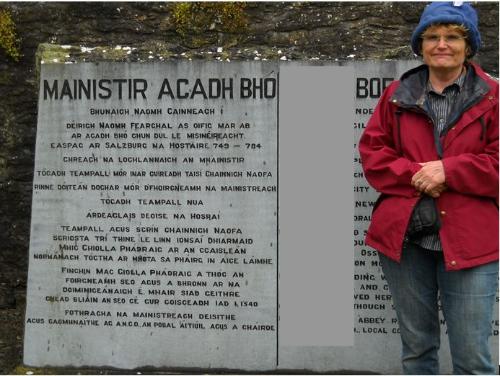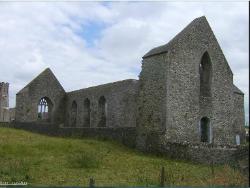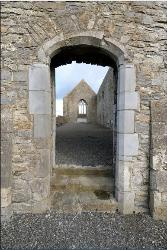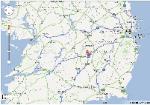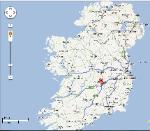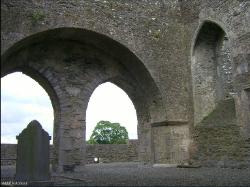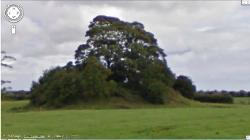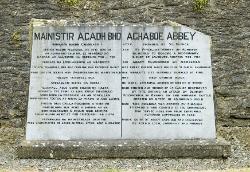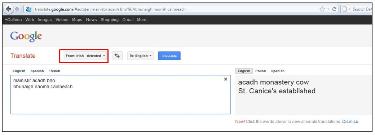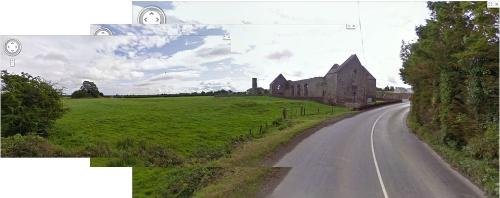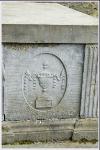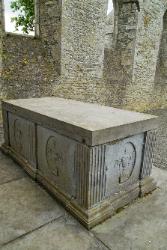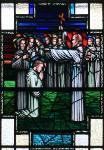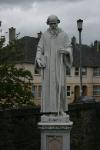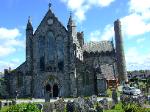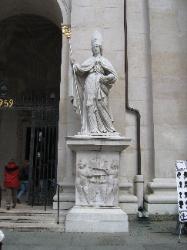| XXX |
| XXX |
Location |

| If you have a picture you'd like us to feature a picture in a future quiz, please email it to us at CFitzp@aol.com. If we use it, you will receive a free analysis of your picture. You will also receive a free Forensic Genealogy CD or a 10% discount towards the purchase of the Forensic Genealogy book. |
| Aghaboe Abbey |
| ********** |
| ********** |

| If you enjoy our quizzes, don't forget to order our books! Click here. |
| Quiz #334 Results |
| Answers: 1. Aghaboe Abbey, near Ballacolla, Co. Laois, Ireland 2. St. Virgil (Feirgal) was a monk at the abbey who became Archbishop of Salzburg. 3. The Fitzpatrick (MacGiollaphaddraigs) have played a major role in the history of the abbey since at least the 1300s. |
| ********** |
| Answer to Quiz #334 December 12, 2011 |
| 1. Where was this photo taken? 2. Was is its connection to Austria? 3. What connection might it have to the family of the Quizmaster General? |
| ********** |
| ********** |
| Congratulations to Our Winners! Daniel Jolley Nicole Blank Robert W. Steinmann Jr. Alan Cullinan Barbara Mroz Margaret Paxton Rachel Joy Shirley Hamblin Milene Rawlinson Marilyn Hamill James L. Brady Collier Smith Carol Farrant Jim Kiser Alan Lemm Margaret Waterman Mike Dalton Barbara Battles Sally Garrison Richard Wakeham Peter Norton Cate Bloomquist |
| Comments from Our Readers |
Good One! I recognized it immediately as Gaelic, I just had to determine if it was Irish
Gaelic or Scottish Gaelic, then realized you were looking for something with regard to
your own family's genealogy, so I started poking around on the Emerald Isle. It would
be a shame if I didn't get get it, being that my high school mascot name was the
"Gaels". Yes, 12 years of Catholic education for me and 16 years (Catholic college) for
my wife, it would really be a shame!. Sorry you haven't heard from me for a while, but
I've been mad busy.
By the way, I have been meaning to tell you, I have become a fan of the show "Hell On
Wheels" on AMC-TV and surprisingly there is a main female character on the show
who had been kidnapped by Native Americans, escaped, and is now a prostitute in a
travelling transcontinental railroad building town (hence "Hell On Wheels") that
replicates our old friend, Olive Ann Oatman Fairchild (1837-1903) from FG Photo Quiz
#'s 285 & 104. The writers have her down perfect, right down to the ritual chin
tattooing on her lower jaw. It is amazing how real life duplicates the goings-on here at
the forensic genealogy photo quizzes, blog, & website!
Robert W. Steinmann Jr.
N.B. Eerie how the media has Forensic Genealogy in their crosshairs. Many times
right after a quiz, I'll see the subject featured on the news. And oh how often has a
Quizmaster reported to me suddenly noticing a quiz photo hanging on the wall of his
favorite restaurant. - Q. Gen.
*****
I presume you are a descendant of Finghin Mac Gillapatrick (Fitzpatrick), Lord
of Ossory, who built the Friary in 1382. So this is where it all started for you
Colleen.
Failte Abhaile. (welcome home)
Alan Cullinan
*****
What a coincidence! My husband and I just finished reading "How The Irish
Saved Civilization".
Barbara Mroz
*****
An earlier building was destroyed in 1346 during an attack by Durmot Fitzpatrick. In
1382 the monastery was rebuilt by Finchin Fitzpatrick and granted to the Dominicans
who remained here for 4 centuries.So the Fitzpatricks appear to be both the bad guys
and the good guys.
Milene Rawlinson
N.B. That just means we are good politicians. - Q. Gen.
*****
It's in Ireland. You had an ancestor who was a monk. He practiced extortion so he had
to flee to Austria. (Now I'll go find a better on-line translator and try again.)
Carol Farrant
*****
The difficult part of this was geting some translations of gaelic to english and
going from there. Of course I had to look at the Fitzpatric Genealogy to connect to
House of Ossory.
Jim Kiser
*****
I was not able to translate the Forensic Genealogy webpage nor the contest photo.jpg
into Irish. By translating various Irish words, I was then able to get a fair idea what the
wording was.The QM had a previous contest where burial place of some Fitzpatricks
was featured.
I would guess the present contest photo was taken about the same time and perhaps on
a rain-sodden day. Another contest photo of QM, perhaps taken a few years later,
shows her standing in the middle of a Canadian town. I think the photo of the spunky
redhead on the Forensic Genealogy website was taken prior to trip to Ireland.
Mike Dalton
N.B. Close. The tomb in the previous quiz photo (Quiz #117, July 8, 2007) was
actually that of James Bulter, 9th Duke of Ormond. The Fitzpatricks and the
Butlers were neighbors in Co. Kilkenney, intermarrying with and murdering each
other, sometimes all at the same time.
This previous photo was taken during our Clan Gathering in 2007. The present
photo was taken in 2010. You are correct, it was taken on a rainy day, but no big
deal - it always rains in Ireland.
The pic of the QGen in Banff (Quiz #256, May 16, 2010) was taken between these
others, and shortly before the 2010 Clan Gathering in July of that year. - Q. Gen.
*****
All I could find about your connection to the Parish of Aghoboe was from an
article on the 'Parish of Aghaboe' on the Irish Midland Ancestry website at
(http://www.irishmidlandsancestry.com/content/laois...htm) In this article there is
mention of a Brian Fitzpatrick: Morgan Cashin, gent, was slain in the Irish ranks, at
Borris-in-Ossory, in 1642. He was the principal man of his name, and, at the time of his
death was found to have been possessed...(jointly with Brian M'William
Fitzpatrick) of [an estate called] Rathdowney, in the [parish of Aghaboe.]
Might that be one of your ancestors? If not, I have no more clues.
This was fun! Google is amazing - even translated some of the Gaelic webpages I
found!
Happy Holidays!
Barbara Battles
*****
Obviously your DNA matches his and not Saint Happy Face's! The antipathy
between the Celts and us Anglo-Saxons goes back a long way.
http://www.virgilofsalzburg.com/
I also followed the red herring of Off'as Dyke, confusing my Gaelic with my
Ancient Welsh. www.britannia.com/celtic/wales/timeline/tl02.html
These are much more fun than parochial American city-scapes.
Do I win a camel stamp for this? (A camel our prized reward in Primary School
from I forget which Presentation Sister, a congregation founded by Nano Nagle.)
Richard Wakeham
N.B. Yes you can have your camel stamp.
As far as the antipathy between us Celts and you Anglo Saxons does go a long way
back, but we all know that it was your fault in the first place. - Q. Gen.
*****
I was looking at other photos of Aghaboe once I solved the quiz. It looks so cool and
the countryside so pretty - I found this photo: www.flickr.
com/photos/thestandingstone/4601001612/ which looked so peaceful. If I ever get
over my fear of flying, Ireland would probably be first on my list to visit. Then
Greece. :)
Nicole Blank
*****
No, I haven’t read [How the Irish Saved Civiilzation]. The closest I’ve gotten to reading
about Ireland is “Trinity”. As I recall, that was particularly UN-cheerful fiction. But, I
have been to Ireland and I love it.
I’m sorry there is no castle in your future. [You are not genetically related to the
Fitzpatricks from Ossory.] On the up-side, you won’t have to pay enormous utility bills
should you have been the next in line to inherit a Fitzpatrick homestead.
Carol Farrant
*****
I loved this week's quiz. I recognized the Irish language right away and any reason to
"go" to Ireland is fine by me, even if it's just to research a photo quiz! My family name
is Flanagan.
I know which book you mean [How the Irish Saved Civilization] and it crossed my
mind while I was working this quiz.
Shirley Hamblin
Gaelic or Scottish Gaelic, then realized you were looking for something with regard to
your own family's genealogy, so I started poking around on the Emerald Isle. It would
be a shame if I didn't get get it, being that my high school mascot name was the
"Gaels". Yes, 12 years of Catholic education for me and 16 years (Catholic college) for
my wife, it would really be a shame!. Sorry you haven't heard from me for a while, but
I've been mad busy.
By the way, I have been meaning to tell you, I have become a fan of the show "Hell On
Wheels" on AMC-TV and surprisingly there is a main female character on the show
who had been kidnapped by Native Americans, escaped, and is now a prostitute in a
travelling transcontinental railroad building town (hence "Hell On Wheels") that
replicates our old friend, Olive Ann Oatman Fairchild (1837-1903) from FG Photo Quiz
#'s 285 & 104. The writers have her down perfect, right down to the ritual chin
tattooing on her lower jaw. It is amazing how real life duplicates the goings-on here at
the forensic genealogy photo quizzes, blog, & website!
Robert W. Steinmann Jr.
N.B. Eerie how the media has Forensic Genealogy in their crosshairs. Many times
right after a quiz, I'll see the subject featured on the news. And oh how often has a
Quizmaster reported to me suddenly noticing a quiz photo hanging on the wall of his
favorite restaurant. - Q. Gen.
*****
I presume you are a descendant of Finghin Mac Gillapatrick (Fitzpatrick), Lord
of Ossory, who built the Friary in 1382. So this is where it all started for you
Colleen.
Failte Abhaile. (welcome home)
Alan Cullinan
*****
What a coincidence! My husband and I just finished reading "How The Irish
Saved Civilization".
Barbara Mroz
*****
An earlier building was destroyed in 1346 during an attack by Durmot Fitzpatrick. In
1382 the monastery was rebuilt by Finchin Fitzpatrick and granted to the Dominicans
who remained here for 4 centuries.So the Fitzpatricks appear to be both the bad guys
and the good guys.
Milene Rawlinson
N.B. That just means we are good politicians. - Q. Gen.
*****
It's in Ireland. You had an ancestor who was a monk. He practiced extortion so he had
to flee to Austria. (Now I'll go find a better on-line translator and try again.)
Carol Farrant
*****
The difficult part of this was geting some translations of gaelic to english and
going from there. Of course I had to look at the Fitzpatric Genealogy to connect to
House of Ossory.
Jim Kiser
*****
I was not able to translate the Forensic Genealogy webpage nor the contest photo.jpg
into Irish. By translating various Irish words, I was then able to get a fair idea what the
wording was.The QM had a previous contest where burial place of some Fitzpatricks
was featured.
I would guess the present contest photo was taken about the same time and perhaps on
a rain-sodden day. Another contest photo of QM, perhaps taken a few years later,
shows her standing in the middle of a Canadian town. I think the photo of the spunky
redhead on the Forensic Genealogy website was taken prior to trip to Ireland.
Mike Dalton
N.B. Close. The tomb in the previous quiz photo (Quiz #117, July 8, 2007) was
actually that of James Bulter, 9th Duke of Ormond. The Fitzpatricks and the
Butlers were neighbors in Co. Kilkenney, intermarrying with and murdering each
other, sometimes all at the same time.
This previous photo was taken during our Clan Gathering in 2007. The present
photo was taken in 2010. You are correct, it was taken on a rainy day, but no big
deal - it always rains in Ireland.
The pic of the QGen in Banff (Quiz #256, May 16, 2010) was taken between these
others, and shortly before the 2010 Clan Gathering in July of that year. - Q. Gen.
*****
All I could find about your connection to the Parish of Aghoboe was from an
article on the 'Parish of Aghaboe' on the Irish Midland Ancestry website at
(http://www.irishmidlandsancestry.com/content/laois...htm) In this article there is
mention of a Brian Fitzpatrick: Morgan Cashin, gent, was slain in the Irish ranks, at
Borris-in-Ossory, in 1642. He was the principal man of his name, and, at the time of his
death was found to have been possessed...(jointly with Brian M'William
Fitzpatrick) of [an estate called] Rathdowney, in the [parish of Aghaboe.]
Might that be one of your ancestors? If not, I have no more clues.
This was fun! Google is amazing - even translated some of the Gaelic webpages I
found!
Happy Holidays!
Barbara Battles
*****
Obviously your DNA matches his and not Saint Happy Face's! The antipathy
between the Celts and us Anglo-Saxons goes back a long way.
http://www.virgilofsalzburg.com/
I also followed the red herring of Off'as Dyke, confusing my Gaelic with my
Ancient Welsh. www.britannia.com/celtic/wales/timeline/tl02.html
These are much more fun than parochial American city-scapes.
Do I win a camel stamp for this? (A camel our prized reward in Primary School
from I forget which Presentation Sister, a congregation founded by Nano Nagle.)
Richard Wakeham
N.B. Yes you can have your camel stamp.
As far as the antipathy between us Celts and you Anglo Saxons does go a long way
back, but we all know that it was your fault in the first place. - Q. Gen.
*****
I was looking at other photos of Aghaboe once I solved the quiz. It looks so cool and
the countryside so pretty - I found this photo: www.flickr.
com/photos/thestandingstone/4601001612/ which looked so peaceful. If I ever get
over my fear of flying, Ireland would probably be first on my list to visit. Then
Greece. :)
Nicole Blank
*****
No, I haven’t read [How the Irish Saved Civiilzation]. The closest I’ve gotten to reading
about Ireland is “Trinity”. As I recall, that was particularly UN-cheerful fiction. But, I
have been to Ireland and I love it.
I’m sorry there is no castle in your future. [You are not genetically related to the
Fitzpatricks from Ossory.] On the up-side, you won’t have to pay enormous utility bills
should you have been the next in line to inherit a Fitzpatrick homestead.
Carol Farrant
*****
I loved this week's quiz. I recognized the Irish language right away and any reason to
"go" to Ireland is fine by me, even if it's just to research a photo quiz! My family name
is Flanagan.
I know which book you mean [How the Irish Saved Civilization] and it crossed my
mind while I was working this quiz.
Shirley Hamblin
Aghaboe (Irish: Achadh
Bhó, meaning "field of
cows") is a village and
parish in County Laois,
Ireland. It is located on the
R434 regional road in the
rural hinterland west of the
town of Abbeyleix, and 30
minutes southwest of
Portaloise, County Laois
St Canice founded Aghaboe
Abbey in 576. In 1346
Bhó, meaning "field of
cows") is a village and
parish in County Laois,
Ireland. It is located on the
R434 regional road in the
rural hinterland west of the
town of Abbeyleix, and 30
minutes southwest of
Portaloise, County Laois
St Canice founded Aghaboe
Abbey in 576. In 1346
References:
www.discoverireland.com/us/ireland-things-to-see-and-do/.....
en.wikipedia.org/wiki/Aghaboe
www.discoverireland.com/us/ireland-things-to-see-and-do/.....
en.wikipedia.org/wiki/Aghaboe
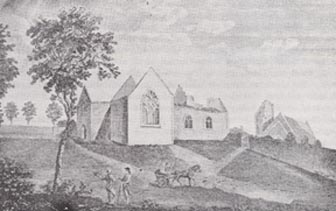
"The one eyed Diarmaid Mac Giollaphádraig ... aided by the Uí Céarbhail ... burned the
town of Aghaboe and the cemetery and church and cruelly forsaking St. Canice, abbot,
patron of the neighbourhood and found of the place, he, like a degenerate son to his
father, burnt and completely destroyed with the crullest fire, the saint's shrine with his
bones and relics."
After being rebuilt in 1189, it served as an Augustinian priory. Later, in 1382, Finghin
Fitzpatrick granted the buildings to the Dominicans, who remained in Aghaboe for 400
years despite their suppression in in the mid-16th century. The ruins that can be seen
today are of an Anglican church dating from the 1700s. Parts of the Augustinian
buildings were incorporated into the church.
The parish comprises the civil parishes of Bordwell and Kylermough, in their entirety;
the town and Coolacurragh in the parish of Coolkerry; all of the civil parish of Aghaboe
lying in Clarmallough; and the parish of Kyledellig, except for about 100 acres (0.40
km2).
town of Aghaboe and the cemetery and church and cruelly forsaking St. Canice, abbot,
patron of the neighbourhood and found of the place, he, like a degenerate son to his
father, burnt and completely destroyed with the crullest fire, the saint's shrine with his
bones and relics."
After being rebuilt in 1189, it served as an Augustinian priory. Later, in 1382, Finghin
Fitzpatrick granted the buildings to the Dominicans, who remained in Aghaboe for 400
years despite their suppression in in the mid-16th century. The ruins that can be seen
today are of an Anglican church dating from the 1700s. Parts of the Augustinian
buildings were incorporated into the church.
The parish comprises the civil parishes of Bordwell and Kylermough, in their entirety;
the town and Coolacurragh in the parish of Coolkerry; all of the civil parish of Aghaboe
lying in Clarmallough; and the parish of Kyledellig, except for about 100 acres (0.40
km2).
Previous to 1855, the portion of the civil
parish situated in the Barony of
Clandonnagh, included moreover, the
portion of the civil parish of Aghaboe
situated in the Barony of Clandonnagh
which with the 100 acres (0.40 km2)
above of Kyledellig, became in that year
the new parish of Borris-in-Ossary. The
present area of the parish is 19,610 acres
(79.4 km2).
parish situated in the Barony of
Clandonnagh, included moreover, the
portion of the civil parish of Aghaboe
situated in the Barony of Clandonnagh
which with the 100 acres (0.40 km2)
above of Kyledellig, became in that year
the new parish of Borris-in-Ossary. The
present area of the parish is 19,610 acres
(79.4 km2).
| including Aghaboe("the field of the Ox") which became his principle monastery. He founded a monastery and Abbey of Aghaboe. Aghaboe grew in importance, and in the 7th century it sent St Feargal as a missionary to the church of Salzburg. Aghaboe become for a time the site of the bishop's see until under Norman influence in the twelfth century the see transferred from Aghaboe to Kilkenny. In 1346 Diarmaid Mac Giollaphádraig burned the town of Aghaboe and the cemetery and church, and completely destroyed Cainnech's shrine along with Cainnech's bones and relics. St. Canice's Cathedral in Kilkenny. Kilkenny (Irish: Cill Chainnigh "The Church of |
| Saint Cainnech of Aghaboe (515/16–600), also known as Saint Canice in Ireland, Saint Kenneth in Scotland, Saint Kenny and in Latin Saint Canicus, was a gaelic abbot, monastic founder, priest and missionary during the early medieval period. Cainnech is one of the Twelve Apostles of Ireland and preached Christianity across Ireland and to the Picts in Scotland. He wrote a commentary on the Gospels, which for centuries was known as the |
| Glas-Choinnigh or the Chain of Cainnech. Most of what is written about Cainnech's life is based on tradition, however he was considered a man of virtue, great eloquence and learning. His feast day is commemorated on 11 October in the Roman Catholic Church and on the 1 or 14 August in the Eastern Orthodox Church. Cainnech spent a good deal of his time in County Meath and Ossory in what is now County Laois. In Ossory he had a good repute with the king, Colmann son of Feradach. Colman gave him grants of land |
| St. Canice Founder of Aghaboe |
| How to Identify the Language and Translate the Inscription |
| Go to www.Google.com/translate. Set the translator to "Detect Language". |
Type a few words of the inscription into the box. The translator will detect the
language as Irish, and give you a rough idea of what the inscription says. There
will be many key words (like "St. Canice" in the example above) that will allow
you to do a Google search and find the answer to the puzzle.
language as Irish, and give you a rough idea of what the inscription says. There
will be many key words (like "St. Canice" in the example above) that will allow
you to do a Google search and find the answer to the puzzle.
| Panorama created from Google Maps street view. |
| Close-up of the Norman motte in the next field. |
| More Photographs of Aghaboe |
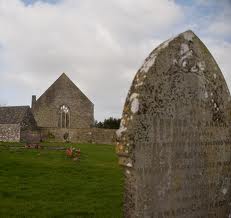
| ********** |
| ********** |
| St. Finnian blessing the Twelve Apostles of Ireland, which included St. Canice. |
| Cainnech") was originally the name of a church erected by or dedicated to Cainnech, but was afterwards extended to the townland and parish. Kilkenny was one of the last parts of Ireland to be |
| converted to Christianity. Tradition asserts that in 597, Cainnech led a Christian force to Kilkenny to eliminate the last bastion of Druidic rule in Ireland. The last Archdruid of Ireland had retired with his Council to a mound in Kilkenny for safety. Cainnech led an army there |
| and overcame them. He founded a monastery near what is now the Church of Ireland's St. Canice's Cathedral. St Cainnech of Aghaboe is the secondary patron of Kilkenny. Read more at en.wikipedia.org/wiki/Saint_Canice |
| St. Virgil |
| ********** |
| ********** |
Vergilius of Salzburg (also Virgilius, Feirgil or Fergal)
(born c. 700 in Ireland; died 27 November 784 in
Salzburg) was an Irish churchman, an early
astronomer and bishop of Salzburg. His obituary calls
him the geometer.
Virgil originated from a noble family of Ireland, where
his name was Feirgil, and was educated in the Iona
monastery. It is controversial whether he is identical
to Abbot Feirgil of Aghaboe Abbey in County Laois.
He is said to have been a descendant of Niall of the
Nine Hostages. In the "Annals of the Four Masters"
and the "Annals of Ulster" he is mentioned as Abbot
of Aghaboe, in County Laois.
Vergilius was made Bishop of Salzburg in 766 or 767
and laboured successfully for the upbuilding of his
(born c. 700 in Ireland; died 27 November 784 in
Salzburg) was an Irish churchman, an early
astronomer and bishop of Salzburg. His obituary calls
him the geometer.
Virgil originated from a noble family of Ireland, where
his name was Feirgil, and was educated in the Iona
monastery. It is controversial whether he is identical
to Abbot Feirgil of Aghaboe Abbey in County Laois.
He is said to have been a descendant of Niall of the
Nine Hostages. In the "Annals of the Four Masters"
and the "Annals of Ulster" he is mentioned as Abbot
of Aghaboe, in County Laois.
Vergilius was made Bishop of Salzburg in 766 or 767
and laboured successfully for the upbuilding of his
Statue of Saint Vergilius at
the Salzburg Cathedral
the Salzburg Cathedral
diocese as well as for the spread of Christianity in neighbouring heathen countries,
especially in Carinthia. He died at Salzburg, 27 November, probably in 784, leaving a
reputation for learning and holiness. In 1233 he was canonized by Gregory IX. His
doctrine that the earth is a sphere was derived from the teaching of ancient geographers.
Reference: en.wikipedia.org/wiki/Vergilius_of_Salzburg
especially in Carinthia. He died at Salzburg, 27 November, probably in 784, leaving a
reputation for learning and holiness. In 1233 he was canonized by Gregory IX. His
doctrine that the earth is a sphere was derived from the teaching of ancient geographers.
Reference: en.wikipedia.org/wiki/Vergilius_of_Salzburg



